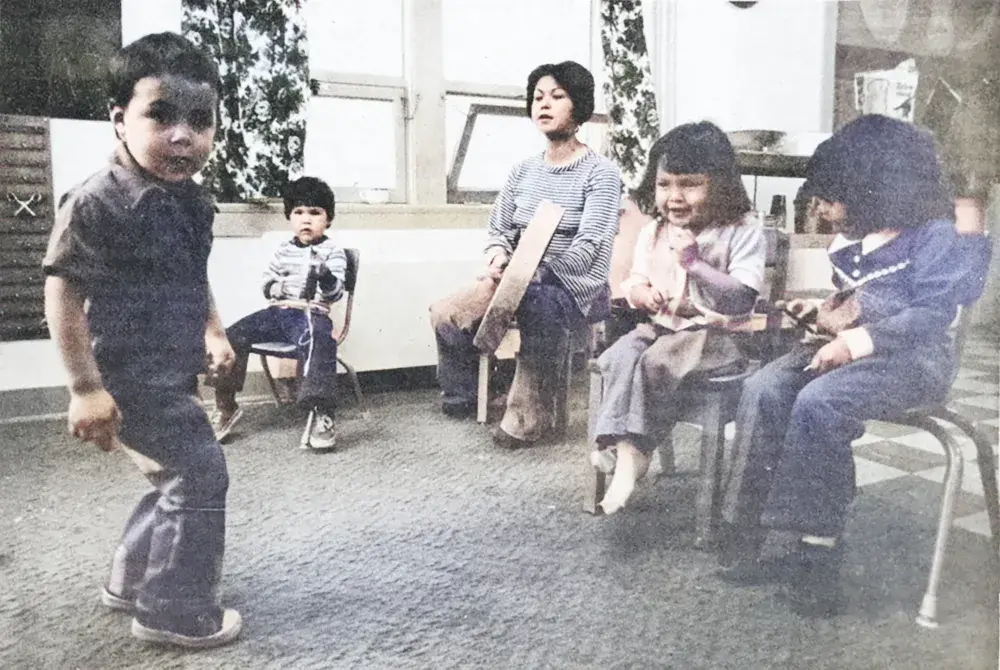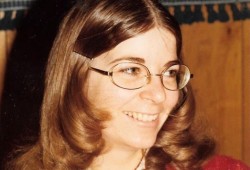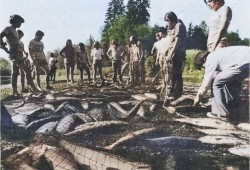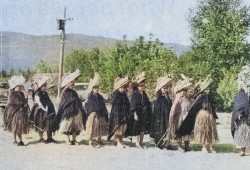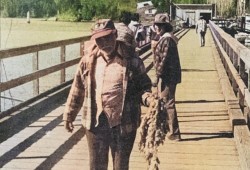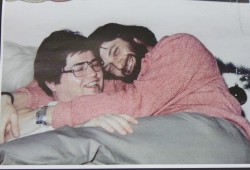A young college graduate answers an ad in the Alberni Valley Times. The West Coast District Council, an early incarnation of the Nuu-chah-nulth Tribal Council, was launching a newspaper and needed staff.
“As I recall, the ad stated that they were looking for a reporter to start a monthly newspaper to serve the people of the 13 west coast tribes,” said Jan Broadland, one of Ha-Shilth-Sa’s first reporters.
It was late 1973 when Jan and her husband, Ken, began looking for work after the couple moved to Port Alberni from Duncan.
“I had a BA in English from U.Vic. and 10 months’ experience working as a reporter-photographer for the Cowichan Leader in Duncan,” she said.
Broadland recalls being very excited to apply for the job, and, it turned out, her brief stint at the Cowichan Leader proved to be the only experience offered by any applicants.
“It was enough to get me hired---a very lucky thing for me as it turned out to be the most interesting and rewarding job I would ever be fortunate enough to have,” she told Ha-Shilth-Sa in an email.
The young reporter was told that the paper’s purpose was to keep people informed about what was happening politically at the district, provincial and federal levels.
“And to also serve as the voice of the people, so that community members could share information about what was happening on the reserve level in the way of social events, sports, economic development, housing, and so on,” said Broadland.
“I remember George (Watts) saying at a tribal council meeting that it would be important to keep all ‘west coast people’ up to date on what was happening and on what the tribal council was doing to help people,” said Tseshaht member Hugh Braker. “I believe he saw the Ha-Shilth-Sa as an important communications tool to keep people informed.”
Braker, a lawyer and past elected chief of Tseshaht, worked for Ha-Shilth-Sa as a summer student in the early days, building the mailing list in the early 1970s.
Back in the days before Ha-Shilth-Sa, the coastal Nuu-chah-nulth communities were even more remote than they are today.
“Some First Nations on the coast still did not have telephones or BC Hydro on their reserves. Many of the roads and highways and the internet, that we take for granted now, did not exist back then,” said Braker.
Braker believes that his late uncle George didn’t appreciate how important the Ha-Shilth-Sa was in unifying the Nuu-chah-nulth people and creating a sense of nationhood.
“We did not know that someone was having a potlatch or that someone had passed away or been born. The Ha-Shilth-Sa changed all that,” he said.
Braker said for his uncle George Watts, it was important to ensure that Nuu-chah-nulth-aht had free access to the paper.
“Given the low income of First Nations people, this was an important decision,” said Braker.
Jill Lewis joined Jan Broadland to begin production of the first newspaper, which still didn’t have a name.
“It was a newspaper for all Nuu-chah-nulth people,” said Charlie Thompson, who was the Ditidaht Band manager at the time.
Thompson recalled what led to deciding on the Nuu-chah-nulth word for ‘interesting news’, a process that took months among the First Nations’ leaders in 1974.
“The discussion went around about what to name it,” he said. “The overall consensus was because Ha-Shilth-Sa was news from Port Renfrew to Kyuquot, it was only natural that we chose Ha-Shilth-Sa.”
Broadland recalls that the first newspaper office was in the former Alberni Indian Residential School building, which was later demolished and replaced by the present-day NTC building.
“I wrote in my memoirs that, ‘The buildings were all massive, heavy-looking, brick-and-mortar structures with no landscaping to soften their gloomy, haunted look’,” she said. “At that time I had no knowledge about residential schools or the sorrow they brought to First Nations people, but I could somehow feel a negativity of spirit within the wall of that building.”
Braker recalls a time when the Ha-Shilth-Sa and WCDC offices were at the Tseshaht Cultural Centre. By that time Bob Soderlund, a lifelong friend of George Watts, was working for the paper. He was hired because of his keen interest in photography. The basement room that served as an office was poorly ventilated, but Bob ran a darkroom out of it.
In 1975 the WCDC moved all of its administrative offices, including the Ha-Shilth-Sa, into Peake Hall, which was also demolished decades later and replaced with a basketball court.
“It had a much friendlier feel to it than the main buildings had,” Broadland shared.
Besides the reporter’s regular tasks of interviewing people, writing stories and taking photos, the fledgling Ha-Shilth-Sa team had to learn old-school layout with literal cutting and pasting of stories in the days before computers and the internet.
After typing out stories on manual typewriters, the team cut their stories into strips to layout on a large storyboard.
“We rolled melted wax on the back of the story strips and then placed them on the big sheets so they would fit where we wanted them, with the wax holding them in place while still allowing them to be adjusted as necessary,” said Broadland. “We would leave blank areas where we wanted photos and label these areas with the photo numbers we wanted to use, then provide the Times with the negatives of the photos so they could print them and add them to the layout.”
In fact Soderlund, who served as Ha-Shilth-Sa editor for more than 20 years, continued the old style of layout up until his retirement in 1998. He would stay at the office late at night to do layout uninterrupted. Known for his beautiful photography, Soderlund also had a darkroom in the corner of his office, where he processed his own rolls of 35mm film.
‘Ha-Shilth-Sa Bob’ Soderlund passed away unexpectedly, in the Philippines in September 2018.
“Suds (as Bob was known) would later say that doctors said his asthma was most likely the result of picture developing in closed, unventilated spaces,” Braker told Ha-Shilth-Sa.
Broadland credits George Watts as the driving force behind launching a Nuu-chah-nulth newspaper from scratch.
“He had laid out the groundwork for us with the A.V. Times and they had agreed to do the type-setting and printing for us as well as to teach us how to do the lay-out,” Broadland recalled.
In its early years the paper was federally funded through a L.I.P. grant (Local Initiatives Program). The Ha-Shilth-Sa team was grateful for the support they received from the A.V. Times, saying they were extremely helpful and didn’t charge much for their services.
“For my dad, the biggest thing I remember about the paper for him was how proud he was that we had it,” said Tseshaht Chief Councillor Ken Watts of his late father, George. “He would talk about how that’s how we got info out to our people in communities and update them. While land claims were always a top priority I also know he thought it was important to celebrate events, milestones and people.”
Broadland describes herself and Jill as young white women back in 1973. She said when they were hired, it was made clear to them that one of their main roles would be to train First Nations people to eventually take over their jobs. She said they believed it was the right thing to do.
Nuu-chah-nulth people were hired to work at the paper, including Charlotte Rampanen, former NTC education manager, the late Eileen Haggard, Pete A. Charlie, Jessie Lucas (Robinson) and the late Lillian Howard, a former NTC co-chair.
In the beginning, Broadland recalls their main interest was to publicize the paper as a new voice for the West Coast people.
“(As) a place to share with each other what was happening in their communities, and a way to become informed about events that were affecting their lives,” she remembered.
The first issues of Ha-Shilth-Sa Newspaper introduced various District Council staff members, invited applications for new job openings and encouraged people to attend District Council meetings so they could see first-hand what was happening.
“In subsequent issues, we responded to suggestions from band members about stories that would interest them, kept people informed about the work that the district staff was doing, and published sports and social news submitted to us by community members,” said Broadland.
During Broadland’s three years at Ha-Shilth-Sa, the biggest issues were land claims, leading to three special editions that focused on this topic. Other important issues included language revitalization and education along with the opening of Ha-Ho-Payuk (now Haahuupayak) school in October 1976.
“These big issues are still in the headlines today, 50 years later, which shows that when dealing with governments, progress can be very slow and requires a LOT of patience and determination!” Broadland noted.
“I have nothing but empathy for what these fine people have suffered in the past and what they continue to deal with today as a result of their children being institutionalized by the church and state in an effort to assimilate them,” she added. “I keep thinking that education should have been the other way around as the First Nations people have so much to teach us non-natives about acceptance, sharing with others and taking care of the environment.”
Other big events Broadland recalls include the time Nuu-chah-nulth chiefs rejected all federal funding from May to September 1975. Later that year, the WCDC hosted the International Conference of Indigenous People at Maht Mahs.
“There are many stories I could tell about my time spent working for the West Coast people and most of my memories are nothing but positive,” said Broadland.
She remembers the First Nations people she got to know were warm and generous, full of fun and laughter, loyal and caring, and some of the best orators she’s ever heard.
“Listening to passionate, unrehearsed speeches by Simon Lucas, George Watts and many others, spoken from the heart and without any notes, was inspirational, especially when they dealt with land claims and the treatment of the natives by the white Europeans who took over their land and their lives and continue to try to dominate over native culture today,” she shared.
She remembers the late Hugh “Tuffy” Watts as a very kind and caring person. The late Nelson Keitlah was passionate when it came to protecting the West Coast fishery resources.
“When I left, in April of 1977, it was because Ken and I were expecting our first child and I wanted to be an at-home mom,” said Broadland.
The couple welcomed their son Dean in May 1977 and moved back to the Cowichan Valley shortly afterwards.
“When I left, Bob (Soderlund) was still there, Charlotte Rampanen was the editor (and a very good one at that) and Eileen Haggard was in charge of advertising and circulation,” said Broadland. “Other band members had given the job a try in the first few years, and I recall that Jessie Lucas (Robinson) and Lillian Howard were both excellent writers and reporters, as was Pete A. Charlie. There have been a number of fine First Nations staff members on the paper since those days and I have always felt that the Ha-Shilth-Sa was in good hands.”
Soderlund remained dedicated to the paper for 24 years, sometimes volunteering his services when funding ran dry. According to Braker, Bob was always ready to hit the road with Nuu-chah-nulth leaders.
“Often George (Watts) would come into the office, look at Suds and say, ‘We gotta go to (wherever) today’. Suds would laugh and just say, ‘ok’. Suds would later say that was why he kept clean underwear in his vehicle,” Braker remembers.

